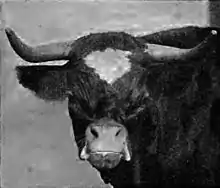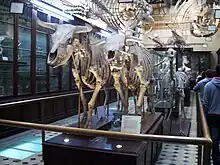Niata cattle
The Niata or Ñata is an extinct breed of dwarf cattle from Uruguay and Argentina.[1]: xxvi It was observed and described by Charles Darwin in the 1830s. One was exhibited at the Segunda Exposición Internacional de Ganadería y Agricultura in Buenos Aires in April 1890. By the early twentieth century the Niata was nearly or completely extinct.
 Photograph of a Niata cow, about 1890 | |
| Conservation status | extinct[1]: xxvi |
|---|---|
| Country of origin |
|
| |

Two Niata skeletons in the Museo de La Plata, in La Plata, Argentina
History
An early description of the Niata is that from November 1833 by Charles Darwin, who twice saw cattle of this type.[2]: 273 [3]: 146 [4]: 332 [5]: 51
George Ernest Gibson bought two in 1889, one of which was exhibited at the Segunda Exposición Internacional de Ganadería y Agricultura in Buenos Aires in April 1890.[2]: 277
By the early twentieth century it was nearly or completely extinct.[2]: 277
References
Wikimedia Commons has media related to Niata.
- Valerie Porter, Lawrence Alderson, Stephen J.G. Hall, D. Phillip Sponenberg (2016). Mason's World Encyclopedia of Livestock Breeds and Breeding (sixth edition). Wallingford: CABI. ISBN 9781780647944.
- Ernest Gibson (1915). Some Notes on the Niata Breed of Cattle (Bos taurus). Proceedings of the Zoological Society of London. 85: 273–277. doi:10.1111/j.1469-7998.1915.tb07417.x.
- Charles Darwin (1845). Journal of researches into the natural history and geology of the countries visited during the voyage of H.M.S. Beagle round the world, under the Command of Capt. Fitz Roy, R.N., second edition. London: John Murray. Note: his account of the Niata is not included in the entry for 18 November 1833 in the first publication of the Journal in 1839.
- Charles Darwin (1868). The Variation of Animals and Plants under Domestication, volume II. London: John Murray.
- Barbara G. Beddall (1975). "Un Naturalista Original": Don Félix de Azara, 1746-1821. Journal of the History of Biology 8 (1): 15–66. (subscription required).
This article is issued from Wikipedia. The text is licensed under Creative Commons - Attribution - Sharealike. Additional terms may apply for the media files.